*NURSING > QUESTIONS & ANSWERS > SOLVED!!! NR 509 COMPREHENSIVE REVIEW OF JARVIS 7TH EDITION CHAPTER 24 (Neurologic System: Physical (All)
SOLVED!!! NR 509 COMPREHENSIVE REVIEW OF JARVIS 7TH EDITION CHAPTER 24 (Neurologic System: Physical Examination & Health Assessment)
Document Content and Description Below
SOLVED!!! NR 509 COMPREHENSIVE REVIEW OF JARVIS 7TH EDITION CHAPTER 24 (Neurologic System: Physical Examination & Health Assessment) ◇This material contains comprehensive summary of information in t... he form of great test questions with descriptive answers helpful for exams study. Thorough Review of Jarvis 7th Edition Chapter 24 Questions. All the best Champions! ______ MULTIPLE CHOICE 1. The two parts of the nervous system are the: a. Motor and sensory. b. c. d. ANS: B The nervous system can be divided into two partscentral and peripheral. The central nervous system includes the brain and spinal cord. The peripheral nervous system includes the 12 pairs of cranial nerves (CNs), the 31 pairs of spinal nerves, and all of their branches. DIF: Cognitive Level: Remembering (Knowledge) MSC: Client Needs: General 2. The wife of a 65-year-old man tells the nurse that she is concerned because she has noticed a change in her husbands personality and ability to understand. He also cries very easily and becomes angry. The nurse recalls that the cerebral lobe responsible for these behaviors is the __________ lobe. NURSINGTB.COM a. b. c. d. ANS: A The frontal lobe has areas responsible for personality, behavior, emotions, and intellectual function. The parietal lobe has areas responsible for sensation; the occipital lobe is responsible for visual reception; and the temporal lobe is responsible for hearing, taste, and smell. DIF: Cognitive Level: Understanding (Comprehension) MSC: Client Needs: Physiologic Integrity: Physiologic Adaptation 3. Which statement concerning the areas of the brain is true? a. The cerebellum is the center for speech and emotions. Frontal Parietal Occipital Temporal Central and peripheral. Peripheral and autonomic. Hypothalamus and cerebral. 358 NURSINGTB.COMPHYSICAL EXAMINATION AND HEALTH ASSESSMENT 8TH EDITION JARVIS TEST BANK Test Bank - Physical Examination and Health Assessment 8e (by Jarvis) b. c. d. ANS: B The hypothalamus is a vital area with many important functions: body temperature controller, sleep center, anterior and posterior pituitary gland regulator, and coordinator of autonomic nervous system activity and emotional status. The cerebellum controls motor coordination, equilibrium, and balance. The basal ganglia control autonomic movements of the body. The motor pathways of the spinal cord synapse in various areas of the spinal cord, not in the thalamus. DIF: Cognitive Level: Understanding (Comprehension) MSC: Client Needs: General 4. The area of the nervous system that is responsible for mediating reflexes is the: a. Medulla. b. c. d. ANS: C The spinal cord is the main highway for ascending and descending fiber tracts that connect the brain to the spinal nerves; it is responsible for mediating reflexes. DIF: Cognitive Level: Remembering (Knowledge) MSC: Client Needs: General 5. While gathering equipment after an injection, a nurse accidentally received a prick from an improperly capped needle. To interpret this sensation, which of these areas must be intact? a. Corticospinal tract, medulla, and basal ganglia b. c. d. ANS: C Pyramidal tract, hypothalamus, and sensory cortex Lateral spinothalamic tract, thalamus, and sensory cortex Anterior spinothalamic tract, basal ganglia, and sensory cortex Cerebellum. Spinal cord. NURSINGTB.COM Cerebral cortex. The hypothalamus controls body temperature and regulates sleep. The basal ganglia are responsible for controlling voluntary movements. Motor pathways of the spinal cord and brainstem synapse in the thalamus. 359 NURSINGTB.COMPHYSICAL EXAMINATION AND HEALTH ASSESSMENT 8TH EDITION JARVIS TEST BANK Test Bank - Physical Examination and Health Assessment 8e (by Jarvis) 360 The spinothalamic tract contains sensory fibers that transmit the sensations of pain, temperature, and crude or light touch. Fibers carrying pain and temperature sensations ascend the lateral spinothalamic tract, whereas the sensations of crude touch form the anterior spinothalamic tract. At the thalamus, the fibers synapse with another sensory neuron, which carries the message to the sensory cortex for full interpretation. The other options are not correct. DIF: Cognitive Level: Applying (Application) MSC: Client Needs: General 6. A patient with a lack of oxygen to his heart will have pain in his chest and possibly in the shoulder, arms, or jaw. The nurse knows that the best explanation why this occurs is which one of these statements? a. A problem exists with the sensory cortex and its ability to discriminate the location. b. c. d. ANS: C The sensory cortex is arranged in a specific pattern, forming a corresponding map of the body. Pain in the right hand is perceived at a specific spot on the map. Some organs, such as the heart, liver, and spleen, are absent from the brain map. Pain originating in these organs is referred because no felt image exists in which to have pain. Pain is felt by proxy, that is, by another body part that does have a felt image. The other responses are not correct explanations. NURSINGTB.COM DIF: Cognitive Level: Understanding (Comprehension) MSC: Client Needs: Physiologic Integrity: Basic Care and Comfort 7. The ability that humans have to perform very skilled movements such as writing is controlled by the: a. Basal ganglia. b. c. d. ANS: B Corticospinal fibers mediate voluntary movement, particularly very skilled, discrete, and purposeful movements, such as writing. The corticospinal tract, also known as the pyramidal tract, is a newer, higher motor system that humans have that permits very skilled and purposeful movements. The other responses are not related to skilled movements. Corticospinal tract. Spinothalamic tract. Extrapyramidal tract. The lack of oxygen in his heart has resulted in decreased amount of oxygen to the areas experiencing the pain. The sensory cortex does not have the ability to localize pain in the heart; consequently, the pain is felt elsewhere. A lesion has developed in the dorsal root, which is preventing the sensation from being transmitted normally. NURSINGTB.COMPHYSICAL EXAMINATION AND HEALTH ASSESSMENT 8TH EDITION JARVIS TEST BANK Test Bank - Physical Examination and Health Assessment 8e (by Jarvis) DIF: Cognitive Level: Understanding (Comprehension) MSC: Client Needs: General 8. A 30-year-old woman tells the nurse that she has been very unsteady and has had difficulty in maintaining her balance. Which area of the brain that is related to these findings would concern the nurse? a. Thalamus b. c. d. ANS: C The cerebellar system coordinates movement, maintains equilibrium, and helps maintain posture. The thalamus is the primary relay station where sensory pathways of the spinal cord, cerebellum, and brainstem form synapses on their way to the cerebral cortex. The brainstem consists of the midbrain, pons, and medulla and has various functions, especially concerning autonomic centers. The extrapyramidal tract maintains muscle tone for gross automatic movements, such as walking. DIF: Cognitive Level: Understanding (Comprehension) MSC: Client Needs: Physiologic Integrity: Physiologic Adaptation 9. Which of these statements about the peripheral nervous system is correct? a. NURSINGTB.COM The CNs enter the brain through the spinal cord. b. c. d. ANS: D A nerve is a bundle of fibers outside of the central nervous system. The peripheral nerves carry input to the central nervous system by their sensory afferent fibers and deliver output from the central nervous system by their efferent fibers. The other responses are not related to the peripheral nervous system. DIF: Cognitive Level: Remembering (Knowledge) MSC: Client Needs: General 10. A patient has a severed spinal nerve as a result of trauma. Which statement is true in this situation? a. Because there are 31 pairs of spinal nerves, no effect results if only one nerve is severed. Efferent fibers carry sensory input to the central nervous system through the spinal cord. The peripheral nerves are inside the central nervous system and carry impulses through their motor fibers. The peripheral nerves carry input to the central nervous system by afferent fibers and away from the central nervous system by efferent fibers. Brainstem Cerebellum Extrapyramidal tract 361 NURSINGTB.COMPHYSICAL EXAMINATION AND HEALTH ASSESSMENT 8TH EDITION JARVIS TEST BANK Test Bank - Physical Examination and Health Assessment 8e (by Jarvis) 362 b. c. d. ANS: C A dermatome is a circumscribed skin area that is primarily supplied from one spinal cord segment through a particular spinal nerve. The dermatomes overlap, which is a form of biologic insurance; that is, if one nerve is severed, then most of the sensations can be transmitted by the spinal nerve above and the spinal nerve below the severed nerve. DIF: Cognitive Level: Applying (Application) MSC: Client Needs: Physiologic Integrity: Physiologic Adaptation 11. A 21-year-old patient has a head injury resulting from trauma and is unconscious. There are no other injuries. During the assessment what would the nurse expect to find when testing the patients deep tendon reflexes? a. b. c. d. ANS: A A reflex is a defense mechanism of the nervous system. It operates below the level of conscious control and permits a quick reaction to potentially painful or damaging situations. DIF: Cognitive Level: Applying (Application) MSC: Client Needs: Safe and Effective Care Environment: Management of Care 12. A mother of a 1-month-old infant asks the nurse why it takes so long for infants to learn to roll over. The nurse knows that the reason for this is: a. A demyelinating process must be occurring with her infant. b. c. Myelin is needed to conduct the impulses, and the neurons of a newborn are not yet myelinated. The cerebral cortex is not fully developed; therefore, control over motor function gradually occurs. Reflexes will be normal. NURSINGTB.COM Reflexes cannot be elicited. All reflexes will be diminished but present. Some reflexes will be present, depending on the area of injury. The dermatome served by this nerve will no longer experience any sensation. The adjacent spinal nerves will continue to carry sensations for the dermatome served by the severed nerve. A severed spinal nerve will only affect motor function of the patient because spinal nerves have no sensory component. NURSINGTB.COMPHYSICAL EXAMINATION AND HEALTH ASSESSMENT 8TH EDITION JARVIS TEST BANK Test Bank - Physical Examination and Health Assessment 8e (by Jarvis) d. ANS: B The infants sensory and motor development proceeds along with the gradual acquisition of myelin, which is needed to conduct most impulses. Very little cortical control exists, and the neurons are not yet myelinated. The other responses are not correct. DIF: Cognitive Level: Applying (Application) MSC: Client Needs: Health Promotion and Maintenance 13. During an assessment of an 80-year-old patient, the nurse notices the following: an inability to identify vibrations at her ankle and to identify the position of her big toe, a slower and more deliberate gait, and a slightly impaired tactile sensation. All other neurologic findings are normal. The nurse should interpret that these findings indicate: a. b. c. d. ANS: C CN dysfunction. Lesion in the cerebral cortex. Normal changes attributable to aging. Demyelination of nerves attributable to a lesion. NURSINGTB.COM Some aging adults show a slower response to requests, especially for those calling for coordination of movements. The findings listed are normal in the absence of other significant abnormal findings. The other responses are incorrect. DIF: Cognitive Level: Analyzing (Analysis) MSC: Client Needs: Health Promotion and Maintenance 14. A 70-year-old woman tells the nurse that every time she gets up in the morning or after shes been sitting, she gets really dizzy and feels like she is going to fall over. The nurses best response would be: a. Have you been extremely tired lately? b. c. d. ANS: D Aging is accompanied by a progressive decrease in cerebral blood flow. In some people, this decrease causes dizziness and a loss of balance with a position change. These individuals need to be taught to get up slowly. The other responses are incorrect. You probably just need to drink more liquids. Ill refer you for a complete neurologic examination. You need to get up slowly when youve been lying down or sitting. The spinal cord is controlling the movement because the cerebellum is not yet fully developed. 363 NURSINGTB.COMPHYSICAL EXAMINATION AND HEALTH ASSESSMENT 8TH EDITION JARVIS TEST BANK Test Bank - Physical Examination and Health Assessment 8e (by Jarvis) DIF: Cognitive Level: Analyzing (Analysis) MSC: Client Needs: Health Promotion and Maintenance 15. During the taking of the health history, a patient tells the nurse that it feels like the room is spinning around me. The nurse would document this finding as: a. Vertigo. b. c. d. ANS: A True vertigo is rotational spinning caused by a neurologic dysfunction or a problem in the vestibular apparatus or the vestibular nuclei in the brainstem. Syncope is a sudden loss of strength or a temporary loss of consciousness. Dizziness is a lightheaded, swimming sensation. Seizure activity is characterized by altered or loss of consciousness, involuntary muscle movements, and sensory disturbances. DIF: Cognitive Level: Applying (Application) MSC: Client Needs: Physiologic Integrity: Physiologic Adaptation 16. When taking the health history on a patient with a seizure disorder, the nurse assesses whether the patient has an aura. Which of these would be the best question for obtaining this information? a. NURSINGTB.COM Does your muscle tone seem tense or limp? b. c. d. ANS: C Aura is a subjective sensation that precedes a seizure; it could be auditory, visual, or motor. The other questions do not solicit information about an aura. DIF: Cognitive Level: Applying (Application) MSC: Client Needs: Physiologic Integrity: Physiologic Adaptation 17. While obtaining a health history of a 3-month-old infant from the mother, the nurse asks about the infants ability to suck and grasp the mothers finger. What is the nurse assessing? a. Reflexes After the seizure, do you spend a lot of time sleeping? Do you have any warning sign before your seizure starts? Do you experience any color change or incontinence during the seizure? Syncope. Dizziness. Seizure activity. [Show More]
Last updated: 1 year ago
Preview 1 out of 24 pages
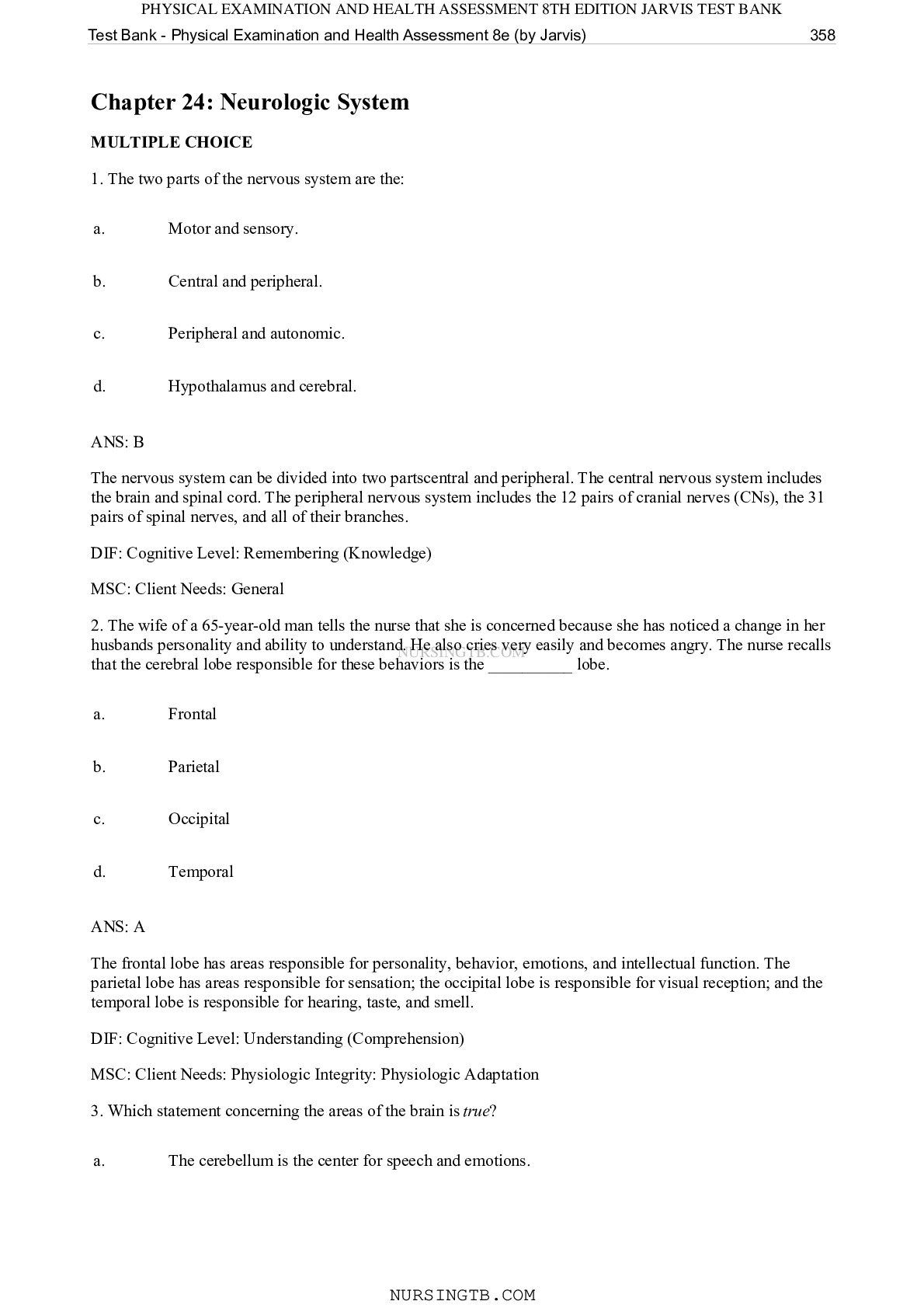
Buy this document to get the full access instantly
Instant Download Access after purchase
Add to cartInstant download
We Accept:

Reviews( 0 )
$15.00
Document information
Connected school, study & course
About the document
Uploaded On
Sep 13, 2021
Number of pages
24
Written in
Additional information
This document has been written for:
Uploaded
Sep 13, 2021
Downloads
0
Views
51

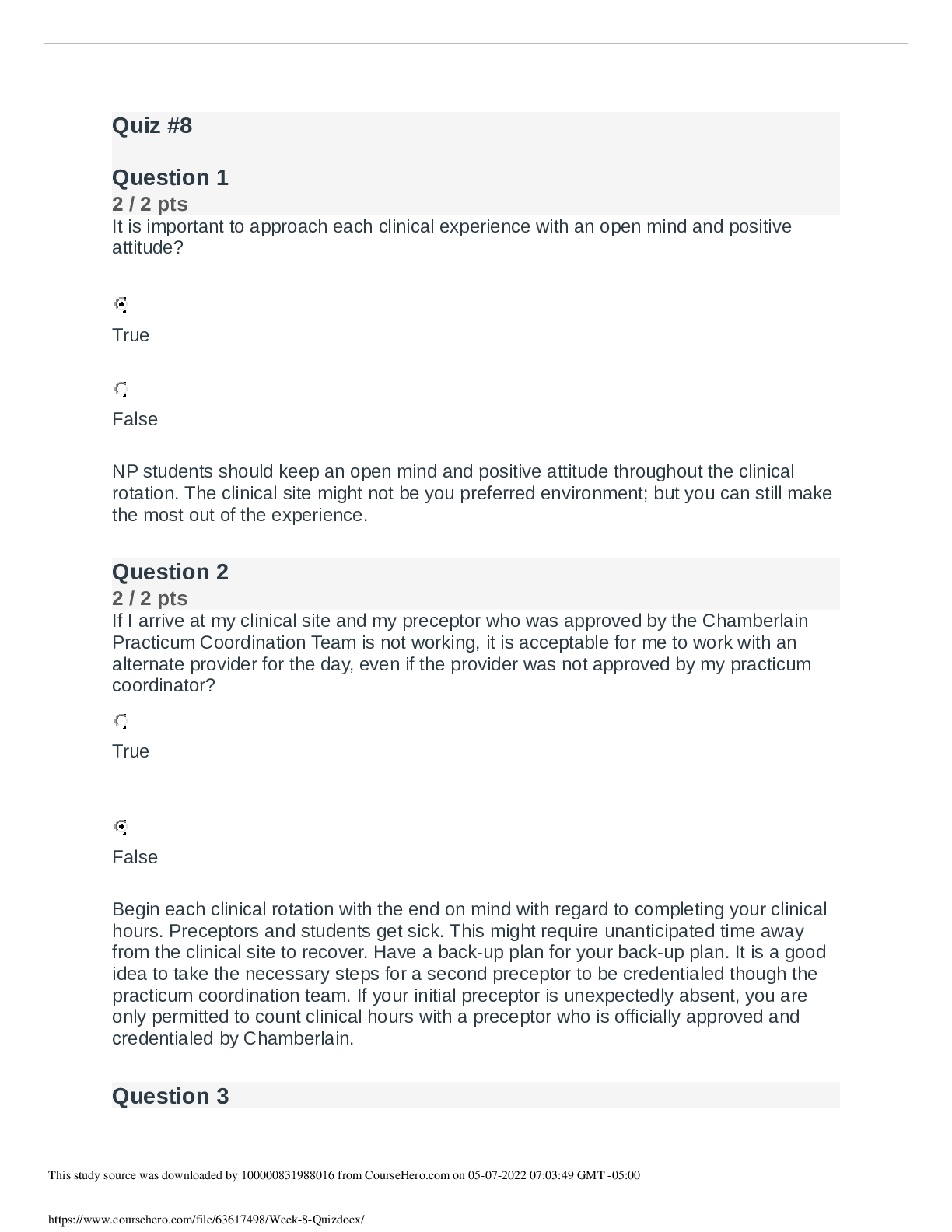



.png)
.png)
.png)
.png)

.png)


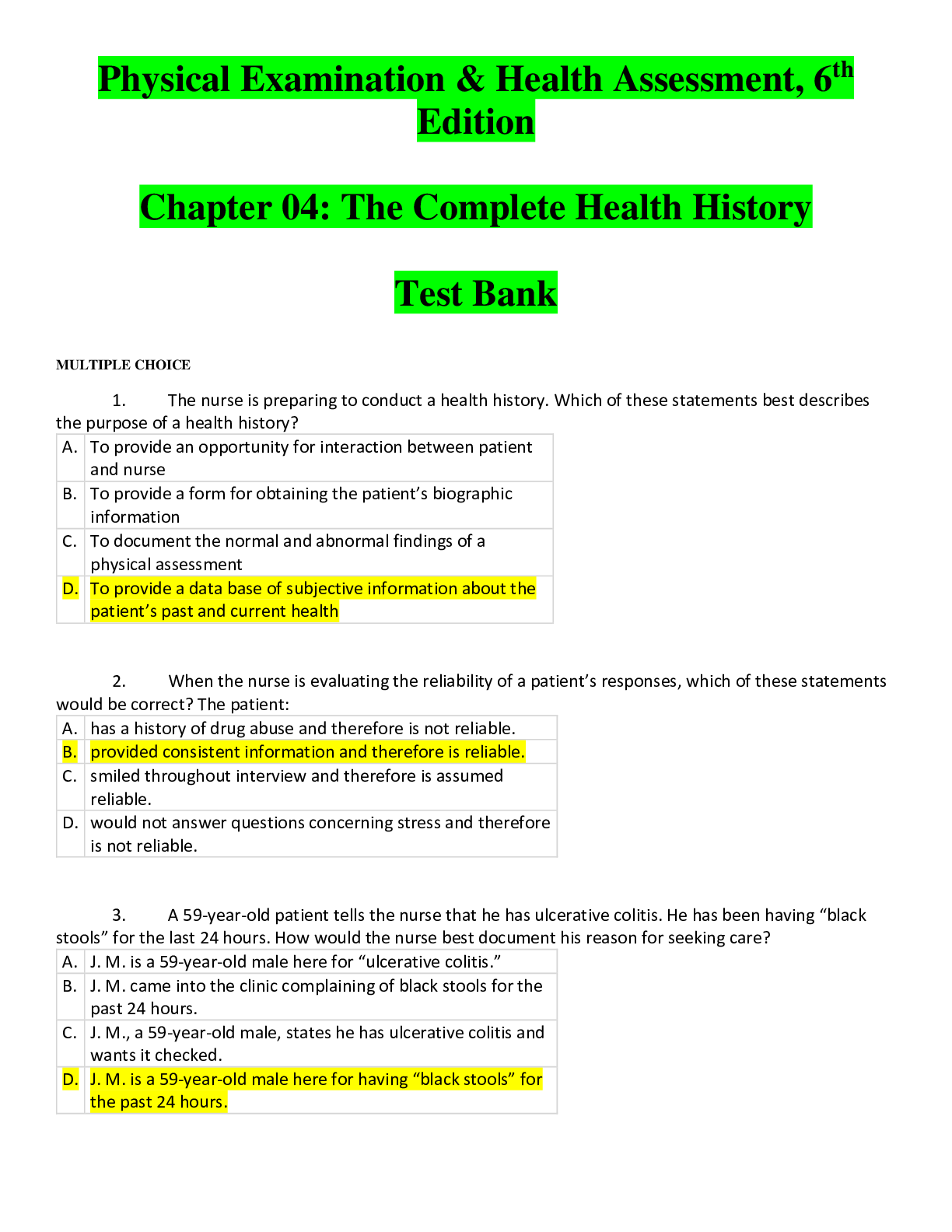
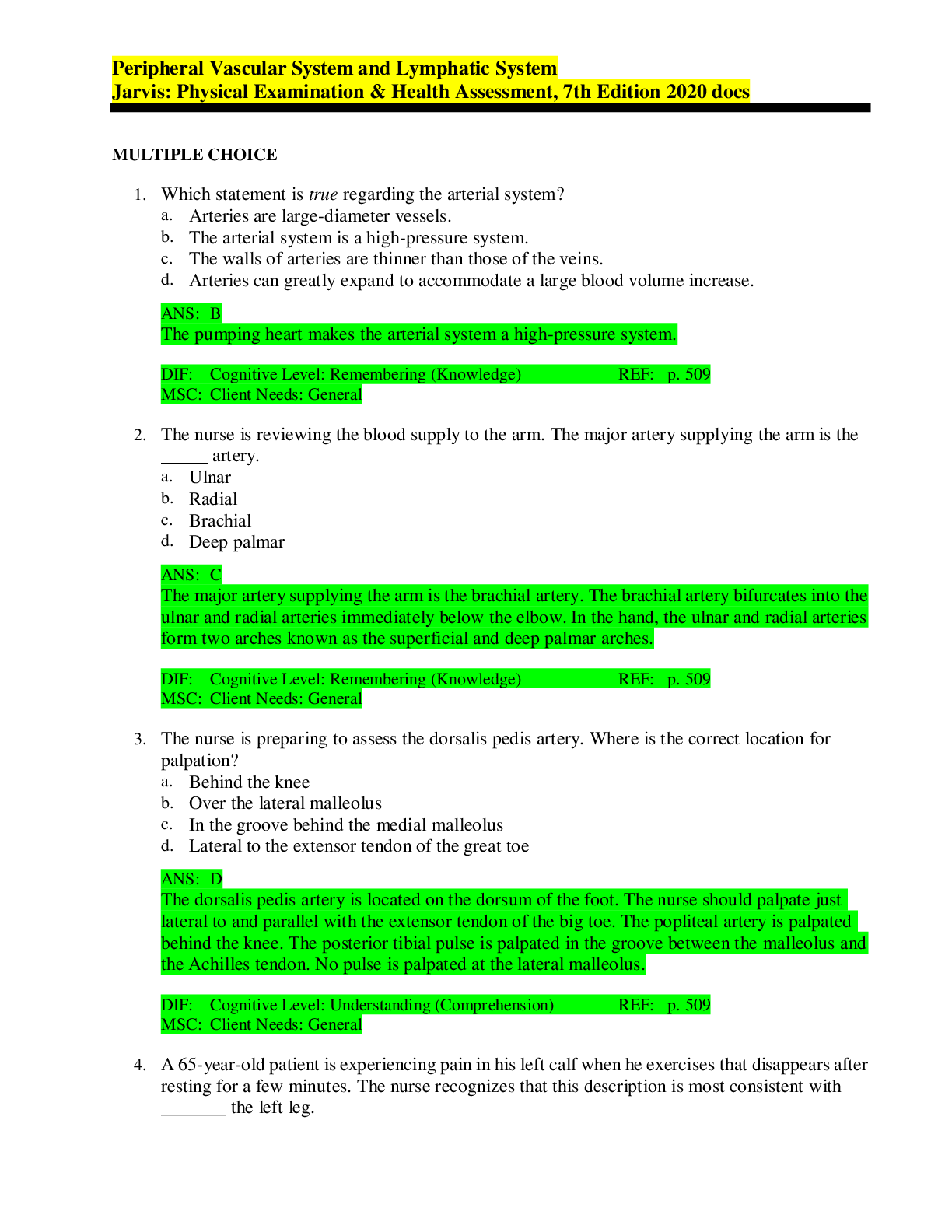
 answers.png)
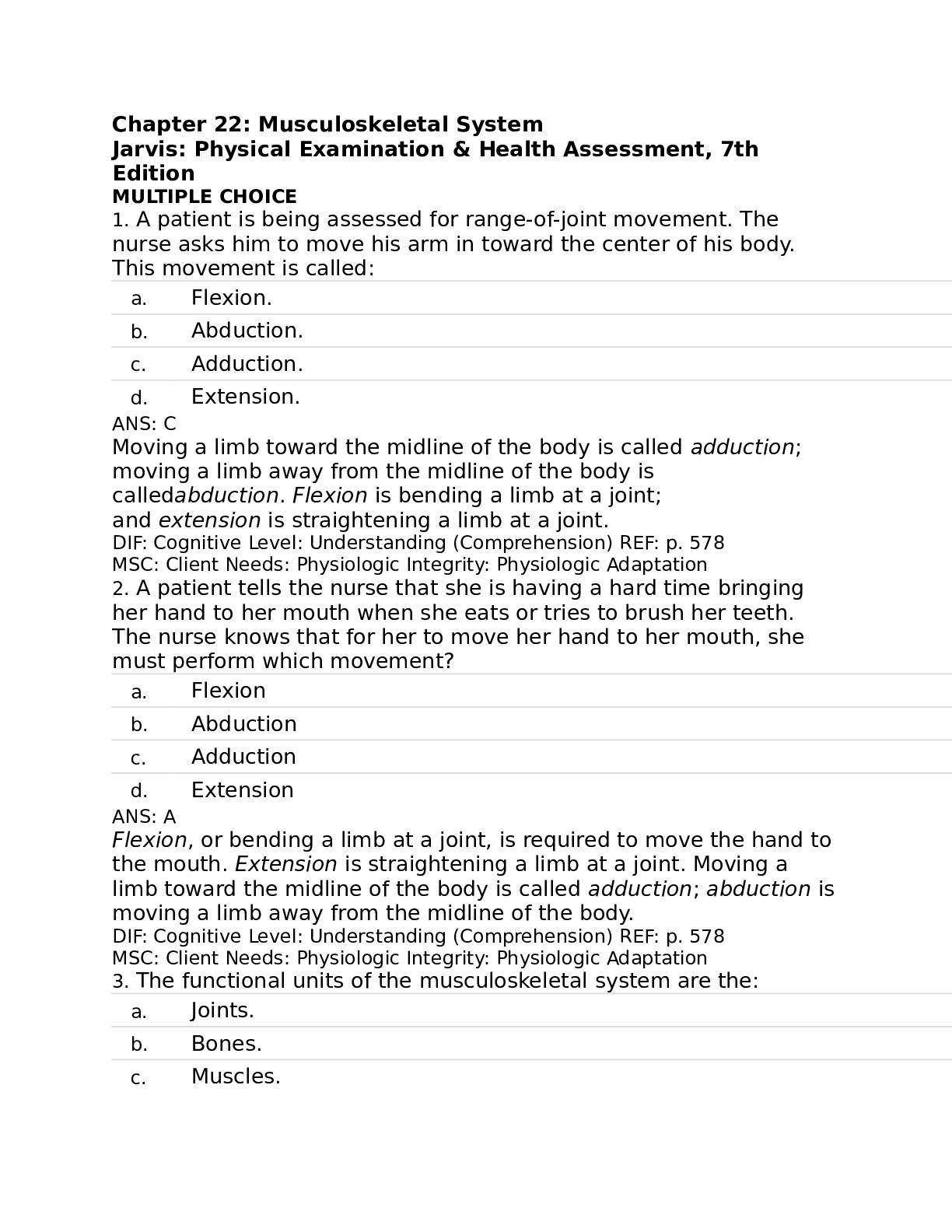
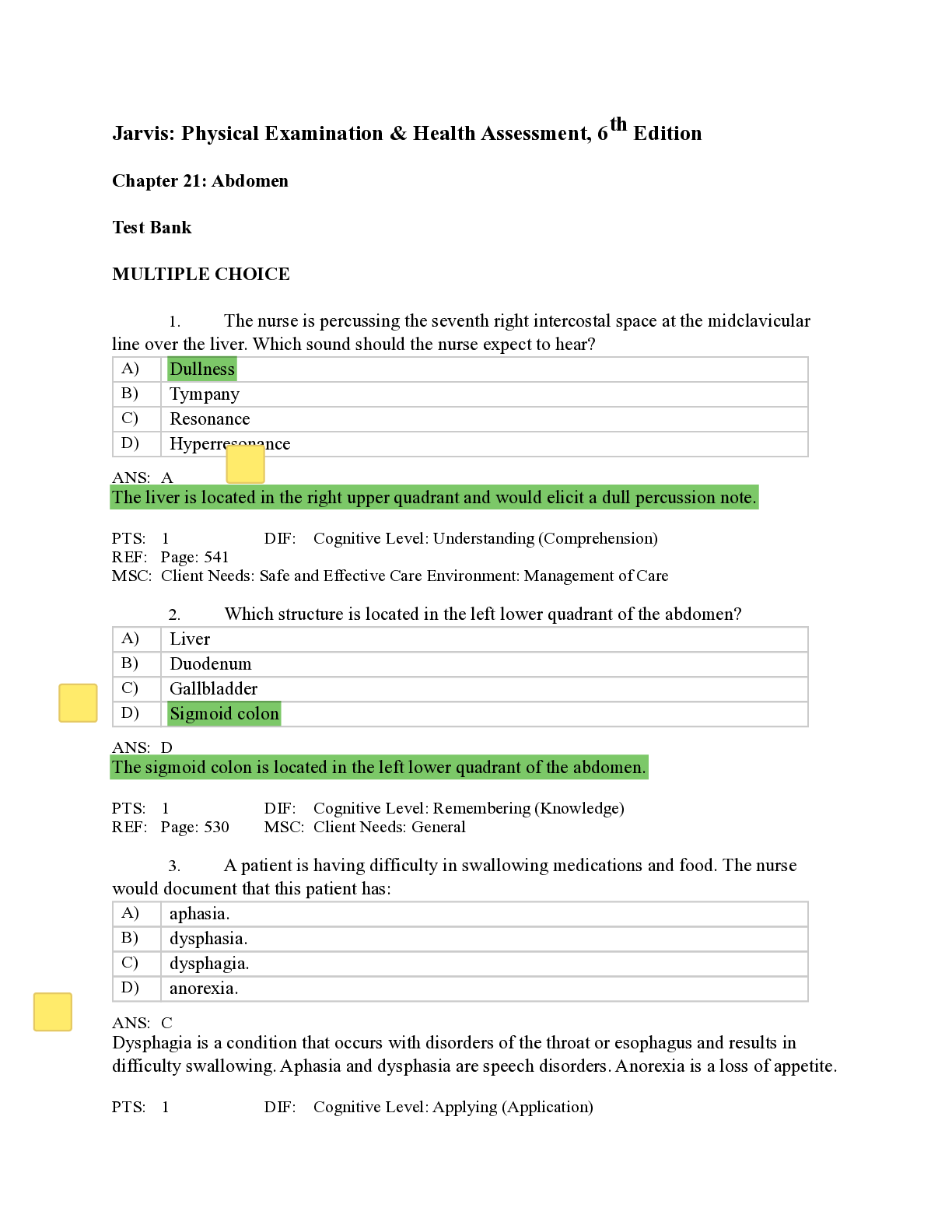
, Latest Questions and Answers with Explanations for Revision, All C.png)
, Latest Questions and Answers with Explanations for Revision, All Correct Latest Review, (La.png)
, Latest Questions and Answers with Explanations for Revision, All Correct Latest Review, (Latest 2021) Correc.png)
, Latest Questions and Answers with Explanations for Revision, All Correct Latest Revie.png)


